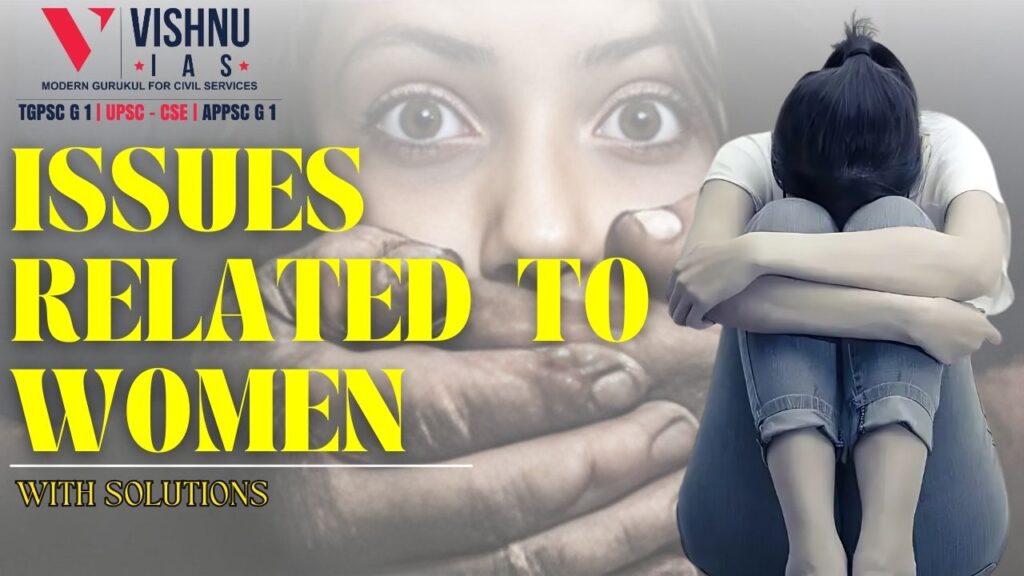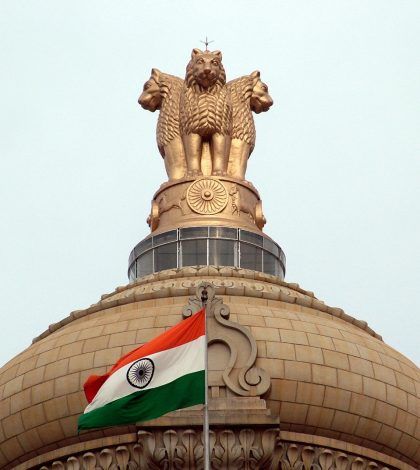list of Issues Related to women
1. Women Health issues
2. Women educational issues
3. Women economical issues
4. At Work place
5. In Corporate World
6. Women Political issues
7. Women in society
8. Women in Public places
9. Women in Families
10. Women in Defence
11. Women in sports
12. Women in Art & science
13. Rural women issues
14. Tribal women issues.
1.Women Health issues
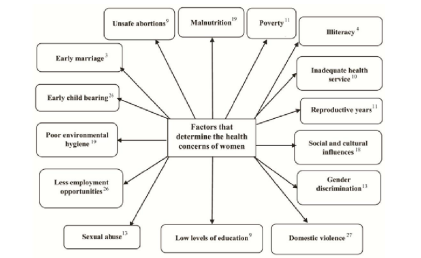
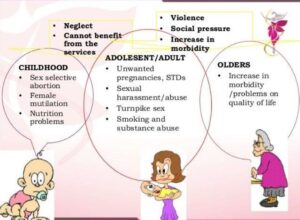
- Women’s disproportionate poverty, low socioeconomic status, gender discrimination and reproductive role not only expose them to various diseases, but also their accesses to and use of health services.
- Domestic violence, rape, and sexual abuse against women affect their productivity, autonomy, quality of life, and physical and mental well being.
- Health status of Indian women report pointed out that women who lost male partner are often forced into prostitution to lead their life. Men transmit the infectious virus to women fourfold than women are to men. Women also acquire HIV infection when they receive blood transfusions to combat pregnancy-related anemia or hemorrhage.
- Sexual abuse during childhood enhances the mental depression and reproductive tract infections in later life, which could often lead to female infertility.
- Malnutrition, due to deficiencies of calories, protein, vitamins, and minerals and other poor health and social status, affects millions of women and adolescent girls around the world. Malnutrition, a serious health concern, threatens the survival of Indian mothers and their children.
- Baby born to malnourished women faces multiple complications, including cognitive impairments, short stature, lower resistance to infections, and a higher risk of disease and death throughout their lives. Women are more prone to nutritional deficiencies than men due to the fact of women’s reproductive biology, low social status, poverty, and lack of education.
- The two most common nutritional deficiencies in the women worldwide are iron deficiency and calcium deficiency. Around 80% of the Indian pregnant women suffer from iron deficiency anaemia.
What is Malnutrition?
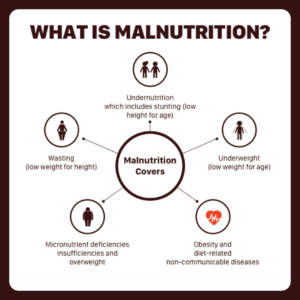
Disorders associated with malnutrition in women
- Good health is a key criterion, which contributes to human wellbeing and economic growth.
- Adequate nutrition for women would help them to serve as productive members of the society to develop the consequent health generations.
- The government should take necessary and compulsory policies to improve the literacy rate and quality education as well as to provide adequate employment opportunities for women, which might explore positive impact on the women’s health concerns. The government can also improve the health status of women by strengthening and expanding essential health services as well as by frequent counseling on safe sex, awareness on educational and nutritional needs and gender based violence.
Women health programs
- Surakshit Matritva Aashwasan
- Janani Suraksha Yojana (JSY)
- Pradhan Mantri Surakshit Matritva Abhiyan
- Pradhan Mantri Matru Vandana Yojana (PMMVY)
- Ayushaman bharat
2.Women educational issues
- The female literacy levels according to the Literacy Rate 2011 census are 65.46%, where the male literacy rate is over 84.04%. While Kerala has the highest female literacy rate and Bihar is at the lowest with only 46.40%.
- Girls If they reach school as kids, adolescent females are the first to drop out. According to statistics, around 63.5 percent female students quit school during adolescence, reasons are
- lack of facilities in schools, especially toilets, giving rise to privacy concerns
- Concern over safety of women
- Incidents of eve-teasing or other forms of harassments on the way to or from the school
- conservative and orthodox families fear on pre-marriage relationship of the girl as well as a potential lack of a suitable match for a qualified girl.
- Several Indian families, till date, prefer spending on their daughter’s marriage than their education
- Religious reasons and cultural pressureS
- Shortage of female teachers
- Less all girls schools and colleges
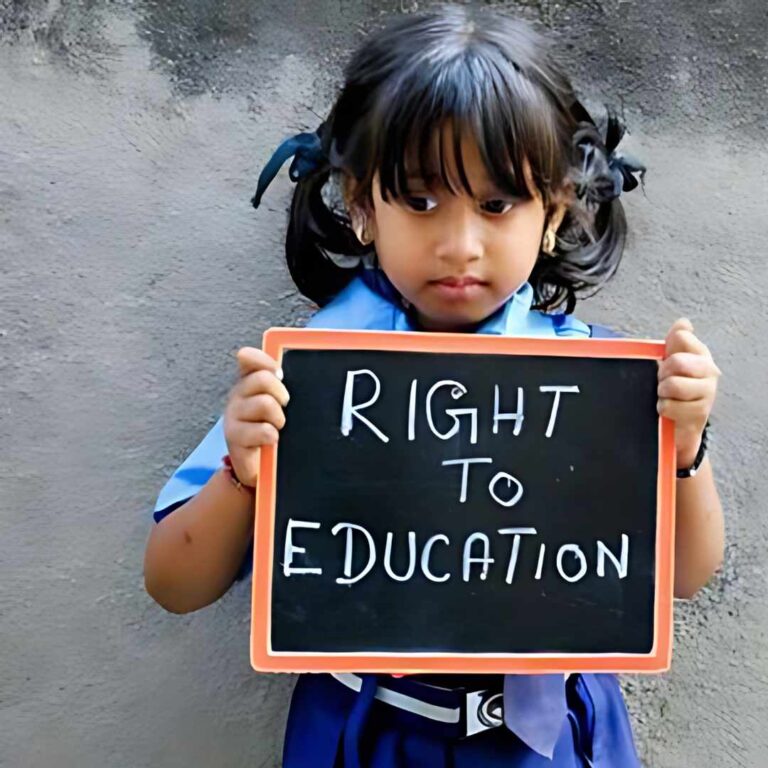
Solutions
a. Sarva Shiksha abhiyan
b. Sukanya Samriddhi Yojana. …
c. National Scheme of Incentive to Girls for Secondary Education. …
d. Balika Saridhhi Yojana. …
e. Rajiv Gandhi Scheme for Empowerment of Adolescent Girls (RGSEAG) …
f. Beti Bachao, Beti Padhao.
g. RMSA Rashtriya Madhyamika shiksha abhiyan
3.Women economical issues
At Work place
- Pregnancy Discrimination
- Sexual Harassment
- Gender Pay Gap
- Race and Ethnicity discrimination.
According to Status of Women in the States: 2015, a project of the Institute for Women’s Policy Research (IWPR), women of colour and immigrants make even less than white women. It’s heart-breaking that after so many years of black women struggle, some still have a hard time making it to the top. Luckily, movements and role models like Michelle Obamaand Oprah Winfrey are shifting these views, but the average working woman is still being faced with this subtle discrimination - Climbing the Career Ladder
- Work-Life Imbalance
- Finally Gender Bias
- Maternity leaves
- Security
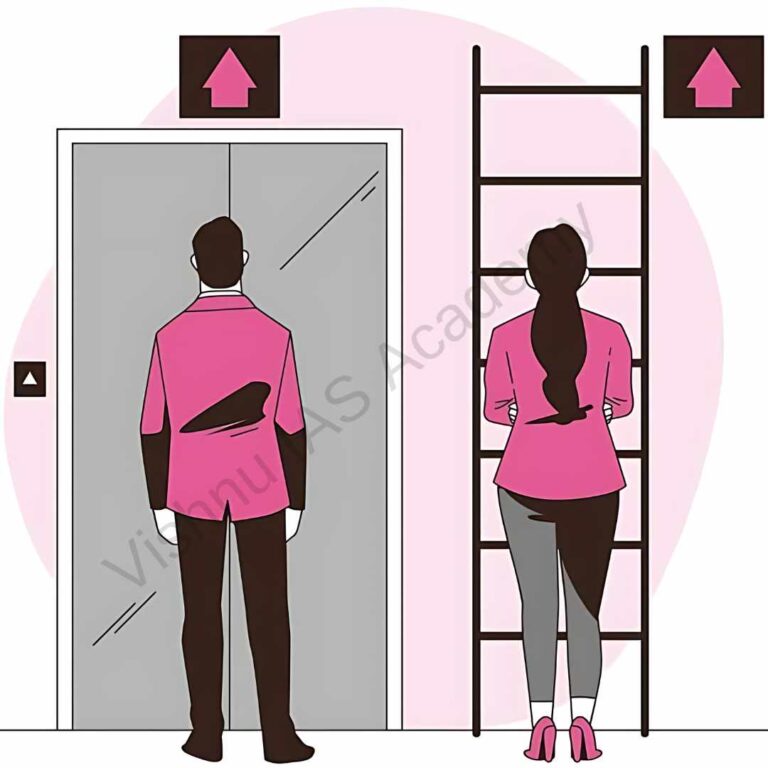
SOLUTIONS
- Flexible schedule
- Let them speak
- Better Behavior
- Sexual Harassment of Women at Workplace (Prevention, Prohibition and Redressal) Act 2013.
Case study : Bhanwaridevi-Rajasthan. Visakha guidelines by supreme court.
The court declared sexual harassment of a working woman at her place of work as amounting to violation of rights of gender equality and right to life.
Definition of Sexual Harassment in the workplace
The court defined sexual harassment in the workplace as an unwelcome sexual gesture or behavior, whether directly or indirectly, This includes
- Sexually coloured remarks
- Physical contact and advances Showing pornography
- A demand or request for sexual favours
- Any other unwelcome physical, verbal/non-verbal conduct that is sexual in nature.
In Corporate World
- Recruitment and hiring practices that createde factoentry barriers for women,
- Aspects of a male-oriented corporate culture that are hostile to women,
- Paternalism
- Allegations of reverse discrimination,
- Sexual harassment
- Different standards for women and men,
- Disparities in the distribution of high-quality job assignments,
- Salary discrepancies based on one’s sex,
- Failure of corporations to accommodate work-family issues, and
- Difficulty for women to advance into management
SOLUTIONS
- Forming grievance cell or complaints committee:
- women need to be self confident and aware of the women rights.
- There are several laws and polices made to ensure women safety at workplace but due to the deficiency of awareness and proper implementation none of them is helpful.
- General Motors CEO: Mary Barra
- IBM CEO & President: Ginni Rometty
4.Women Political issues
Issues & Challenges:
- Socio-cultural factors
- Religious factors
- Gender roles-patriarchy
- Family work and time constraints
- politics is reputed to be dirty
- Pseudo women leaders under Male
- Under Representation in politics(In Loksabha only 12.54%of females present)
- Low education and empowerment
- Gender violence
Ex: Benazir bhutto
SOLUTIONS
- 73rdand 74thConstitutional Amendment act provides one third reservation to
- women in local bodies.
- Gender Responsive Governance (GRG) that promotes women’s empowerment
- and promote gender equity and social justice.
- Women’s Reservation Billor The Constitution (108th Amendment)Bill, 2008
- Increased Women Voters Turn-outs
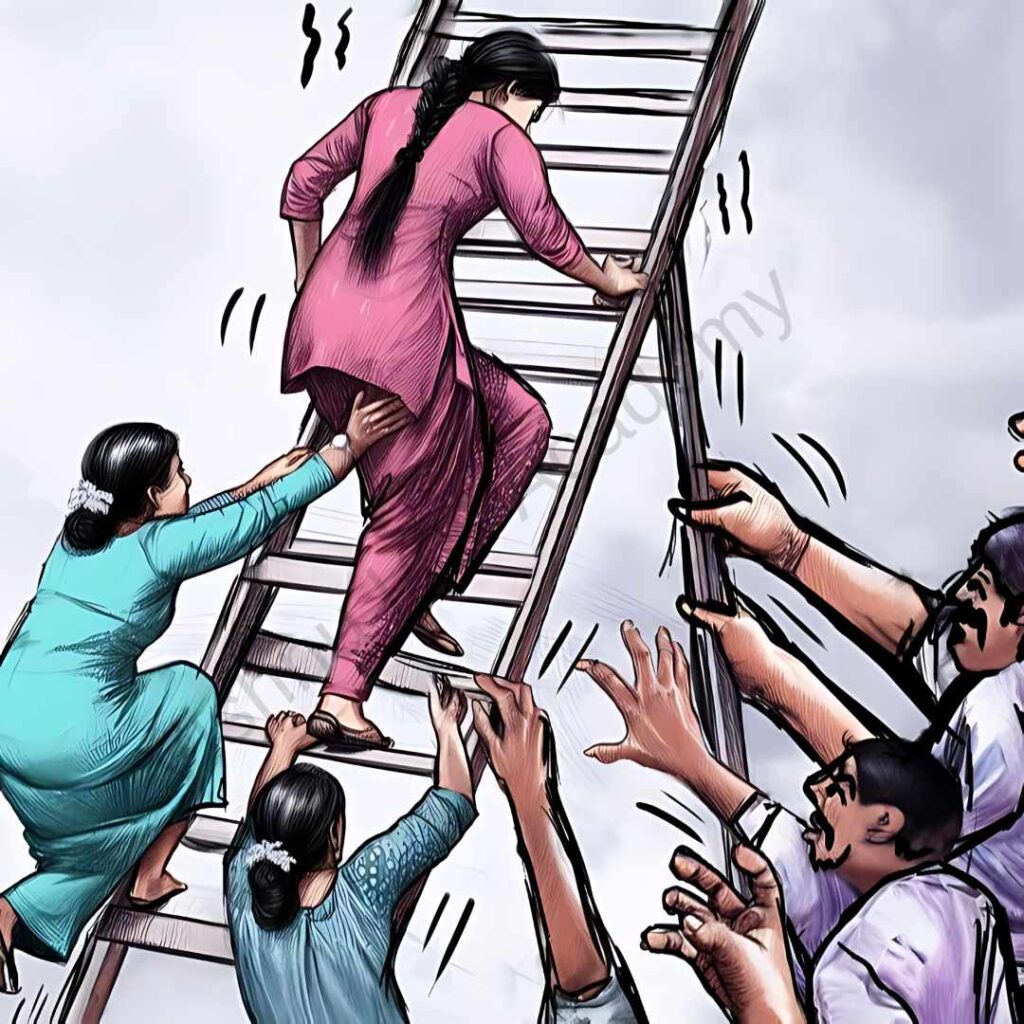
5.Women in society
- Sexism and Gender Bias: The “glass ceiling” is a popular phrase that women have been striving to break through for decades. It refers to gender equality, primarily in the workforce
- Female genital mutilation As per UNICEF estimate in 2016 around 200 million women currently living in 30 countries have experienced this. In India Dawoodi Bohras who constitute a small section of Muslim Shias practice the ritual of FGM.
- Stereotype mentality of the society
- Over sexualization (Commodification and objectification of women)
- Rape is not Properly Prosecuted (One out of every five women is a victim of sexual assault)
- Selective Abortion and female infanticide.
- Support girls and women in crisis
- Promote Gender Equality
- Gender Empowerment
- Stop any form of violence against women
- Empowering women at homes, No discrimination for girl child in families
- Sensitising police and government functionaries regarding women issues.
- PCPNDT Act, 1993
6.Women in Public places
- Eve Teasing is a common phenomenon
- Stereotype: Men own public spaces.
- A woman in a public space is immediately an object of consumption
- Obscene advertisements of women on Hoardings
- No fixed places for Prostitution in various cities and illegal prostitution
- Patriarchal mind set
SOLUTION
- Involve women and girls more in every stage ofurban design(Last Mile
- connectivity and public Transportation)
- Pay more attention toall women’s voicesto ensure we feel relaxed and safe
- inpublic spaces
- Plug the knowledge gapon what makes public space more inclusive, what girls
- and women want
- Adapt participatory methodsto be welcoming and appropriate.
- The Indecent Representation of Women (Prohibition) Act, 1986:
- The Information Technology Act, 2000:
- J.S Verma committee recommendations after Nirbhaya,2012
- Criminal Law Amendment Act 2013
- Immoral Trafficking Prevention Act, 1956 and LokSabha passed the Trafficking of Persons(Prevention, Protection and Rehabilitation) Bill,2018.
Salient Features of the Anti-trafficking Bill, 2018
- A National Anti-Trafficking Bureau (NATB)will be established for coordinating, monitoring and surveillance of trafficking cases. It will also deal with crimes having interstate ramifications.
- Anti-Trafficking Relief and Rehabilitation Committees to be established at the national, state, and district levels.
- Anti-Trafficking Units: ATUs will deal with the prevention, rescue, and protection of victims and witnesses, and for the investigation and prosecution of trafficking offences.
7.Women in Families
- Women Are More Likely to Be Victims of Domestic Violence
- Insufficient Access to Sanitation Facilities
- Poor Medical Care and Access to Health Information
- No educational Oppurtunity
- No decision making power
- Dowry Harrasment
- Child Marriages
- Marital Rape
- Issue of triple Talaq
Solutions
- Lorem ipsum dolor sit amet, consectetur adipiscing elit. Ut elit tellus, luctus nec ullamcorper mattis, pulvinar dapibus leo.THE PROTECTION OF WOMEN FROM DOMESTIC VIOLENCE ACT, 2005
- IPC Section 498A-Dowry Harassment AND cruelty against Wife
- Dowry prohibition act 1961
- The Prohibition of Child Marriage Act, 2006
- National Commission for Women Act, 1990
- The LokSabha has passed the Muslim Women (Protection of Rights on Marriage) Bill, famously referred to as Triple TalaqBill.
- The Bombay High Court in a landmark verdict allowed entry of women in to the Sufi dargah in Mumbai
8.Women in Defence
- Less representation in Defence and DRDO
- Women is not allowed into Combat operations where as in Israel and other western countries allow women into combat forces.
- Glass ceiling is the biggest hurdle. Patriarchal mindset is the reason behind it.
- Note: Punjab and Haryana HC held that women cannot be permanently barred from joining the Army Medical Corps AND ARMED FORCES for reason of pregnancy.
Solutions
- Tessy Thomas shot to popularity as the ‘Agni Putri’, or Missile Woman, after the successful launch of the long distance Agni-4 missile in 2011, nearly a dozen women today drive projects —from those of strategic importance to taking care of planning and coordination at the DRDO.
- Government had a proposal to launch women into Combat roles and into Permanent Commission.
- Punita Arora is the first woman in India to don the second-highest rank, Lieutenant General of Indian Armed Forces,as well as the rank of Vice Admiral of Indian Navy.
- Nirmala Sitharaman is a first women Defence minister of india
- Women to get 20%jobs in Military Police from 2019.
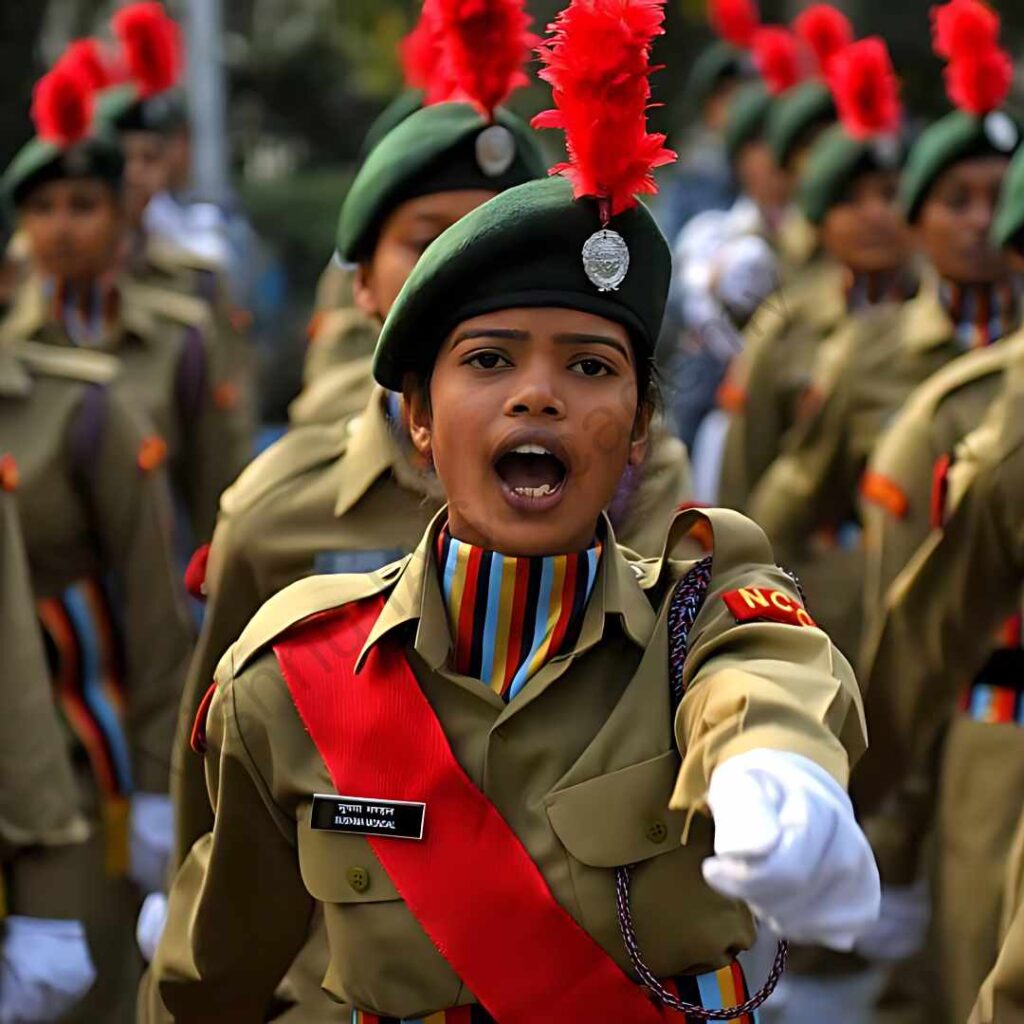
9.Women in sports
Note: The low female participation in sports is evident from the fact that only five women from India have been able to bring home Olympics medals so far
{KarnamMalleswari, Mary Kom, SainaNewhwal, P.V. Sindhu& SakshiMalik}.
- Female athletes AND sports women have to face is being paid half or less of what is given to their male counterparts. Ex: he prize money for the winners of the FIFA World Cup(male) would be roughly between $35–50 million , while the prize money for the winners of the Women’s FIFA World Cupwas roughly about $2 million.
- Lack of media coverage
- Prejudices and misconceptions due to cultural and religious concerns(poor self-confidence or self-efficacy, limited participation options and safety considerations)
- Less Female role models AND incidence of sexual harassment issues.
- Economic constraints AND absence of family support
- Female sports campaigns are absent in India. Ex: England’s “This Girl Can” campaign.
- They’ve been sexualized and objectified.
- Politics and favoritism in the selection procedure; lack of sports infrastructure; lack up funds and coaching related issues are common for both sports MEN and WOMEN.
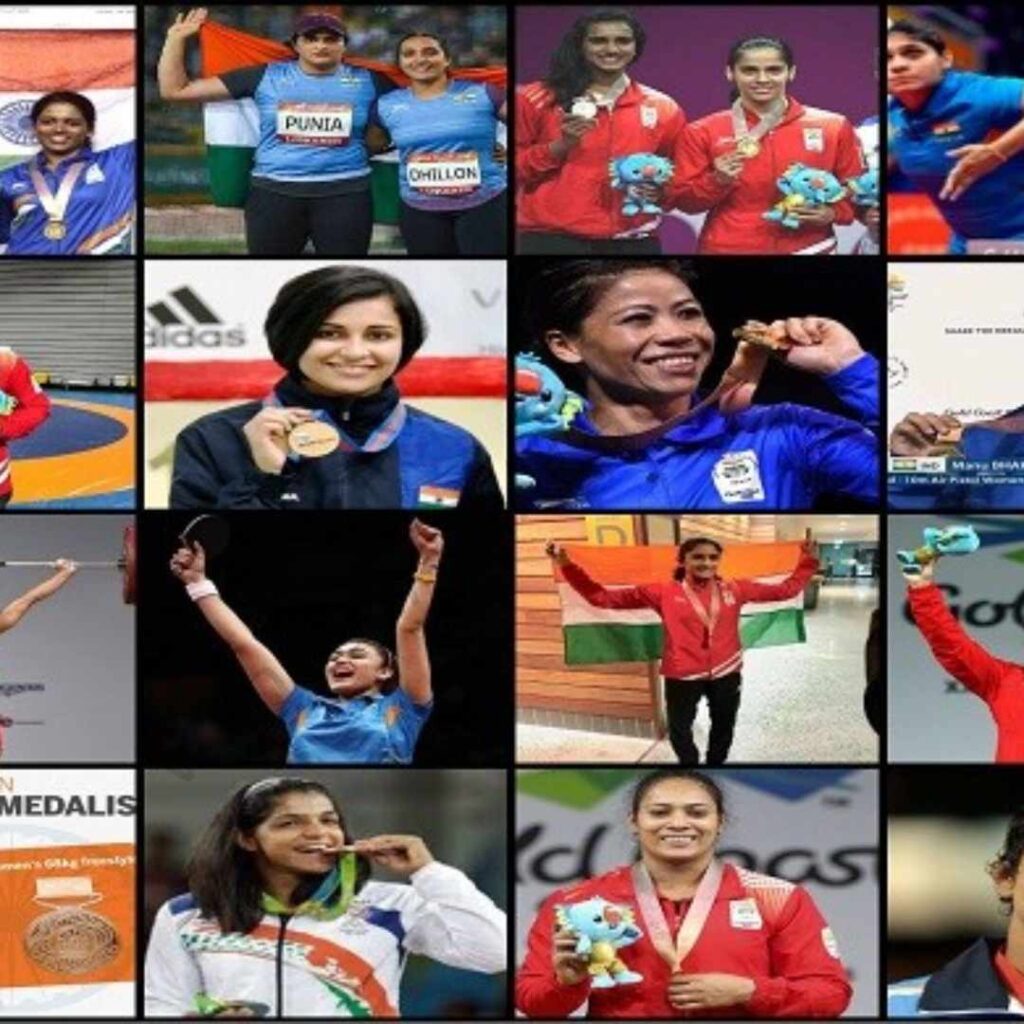
Solution
- Required government intervention, in the context of encouraging female participation in sport.
- Provide more leadership opportunities for women across all sectors of the sports industry.
- Focus on inclusion (Enhance Female participation)
- Change the mindset that women do not have a role in sports.
- National Youth Policy, 2003 and National Commission for Youth (2004) emphasized for Gender justice in Indian sports
10.Women in Art&science
- Lack of Education and discouragement from families to pursue higher education.
- Gender discrimination(There is a belief that Arts for women and science for men)
- Favoritism only limited families have accessiblityto Arts and science
- Absence of government policy to pursue arts and science
- Continual discouragement to pursue STEM(Science, Technology, Engineering and Maths)
Solution
- NATIONAL POLICY FOR THE EMPOWERMENT OF WOMEN (2001)
- The Union Ministry of Science & Technology also announced KIRAN (Knowledge, Involvement, Research, Advancement through Nurturing) for women scientists–A unique advertising scheme to bring about, as far as possible, gender equality in the field of S&T.
- PM ManmohanSingh inaugurated a new science policy, the Science, Technology and Innovation Policy (STI) 2013that lays greater emphasis on innovation, setting up research institutes and encouraging women scientists with an aspiration to place itself among the top five scientific powers in the world by 2020.
- The Ministry of Women and Child Development, Government of India has launched an online campaign Web-Wonder Women to discover and celebrate the exceptional achievements of women, who have been driving positive agenda of social change via social media through ARTS.
11.Rural women issues
- Male dominance
- Absence of land rights
- Poor Sanitation and drinking water facilty
- Lack of education & Health Infrastructure
- Domestic Violence and Gender Discrimination
- Child marriages
- Undernourishment
Solution
- Self-help group POSHAN Abhiyaan(National Nutrition Mission) is a flagship programmeof the
- Ministry of Women and Child Development. The Mission is aimed at improving the nutritional status of Children from 0-6 years, Adolescent Girls, Pregnant Women and Lactating Mothers in a time bound manner during the next three years beginning 2017-18.
- The International Day of Rural Women is observed every year on October 15
- to recognize the crucial role and contribution of rural women.
- Enhancing Financial Inclusion & Financial Services
- 73rdConstitutional act for Political Participation
12.Tribal women issues
- Economic problems due to deforestation and land-alienation and land acquisition
- Culture shock and Exploitation at work-place
- Lack of basic amenities like Drinking water facility and sanitation
- Taboos and the place of women in the traditional tribal religion. Ex: Among the Jaunsari, women have no place in matters of religion and ritual performances. Among the Toda and Kota of Southern India, the women are prohibited from crossing the threshold of a temple.
- Killing tribal women on the name of sorcery and witches
- PVTG’S and Criminal tribes(Habitual Offenders )
Solution
- Van Dhan Scheme of Ministry of Tribal Affairs and Tribal Cooperative Marketing Development Federation of India (TRIFED) aims at economic development of tribals involved in collection of Minor Forest Produces (MFPs) and constitution of SHG’S.
- The Scheduled Tribes (STs) and Other Traditional Forest Dwellers (OTFDs) (Recognition of Forest Rights) Act, 2006 is being implemented to recognize and vest the forest rights and occupation in forest land to forest dwelling STs.
- Eklavya Model Residential Schools (EMRSs)
- Sc,Statrocities act 1989
- Vaagdhara NGO working for tribal women empowerment
- VOYEURISM
- STALKING
- RTE
- RTI
- RTF
- RTH
- RMSA Rashtriya Madhyamika shiksha abhiyan

